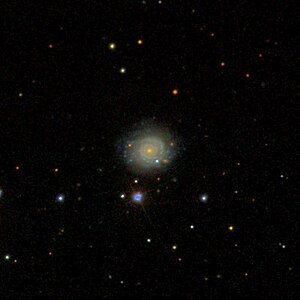NGC 226
| Galaxie NGC 226 | |
|---|---|
 | |
| SDSS-Aufnahme | |
| AladinLite | |
| Sternbild | Andromeda |
| Position Äquinoktium: J2000.0, Epoche: J2000.0 | |
| Rektaszension | 00h 42m 54,0s[1] |
| Deklination | +32° 34′ 51″[1] |
| Erscheinungsbild | |
| Morphologischer Typ | Sab?[1] |
| Helligkeit (visuell) | 13,4 mag[2] |
| Helligkeit (B-Band) | 14,4 mag[2] |
| Winkelausdehnung | 0,9′ × 0,6′[2] |
| Positionswinkel | 105°[2] |
| Flächenhelligkeit | 12,6 mag/arcmin²[2] |
| Physikalische Daten | |
| Zugehörigkeit | NGC 266-Gruppe NGC 315-Gruppe LGG 14[1][3] |
| Rotverschiebung | 0,016111 ± 0,000007[1] |
| Radialgeschwindigkeit | (4830 ± 2) km/s[1] |
| Hubbledistanz H0 = 73 km/(s • Mpc) | (223 ± 16) · 106 Lj (68,4 ± 4,8) Mpc [1] |
| Durchmesser | 60.000 Lj[4] |
| Geschichte | |
| Entdeckung | John Herschel |
| Entdeckungsdatum | 22. November 1827 |
| Katalogbezeichnungen | |
| NGC 226 • UGC 459 • PGC 2572 • CGCG 500-076 • IRAS 00402+3218 • 2MASX J00425403+3234516 • GC 121 • h 53 • GALEXASC J004254.05+323451.1 • LDCE 43 NED002 | |
NGC 226 ist eine Spiralgalaxie vom Hubble-Typ Sab? im Sternbild Andromeda am Nordsternhimmel. Sie ist schätzungsweise 223 Millionen Lichtjahre von der Milchstraße entfernt ist und hat einen Durchmesser von etwa 60.000 Lichtjahren.
Das Objekt wurde am 22. November 1827 vom britischen Astronomen John Herschel entdeckt.[5]
Weblinks
Einzelnachweise
Auf dieser Seite verwendete Medien
Autor/Urheber: Sloan Digital Sky Survey, Lizenz: CC BY 4.0
The sky image is obtained by Sloan Digital Sky Survey, DR14 with SciServer.
Angle of view: 4' × 4' (0.3" per pixel), north is up.
Details on the image processing pipeline: https://www.sdss.org/dr14/imaging/jpg-images-on-skyserver/
